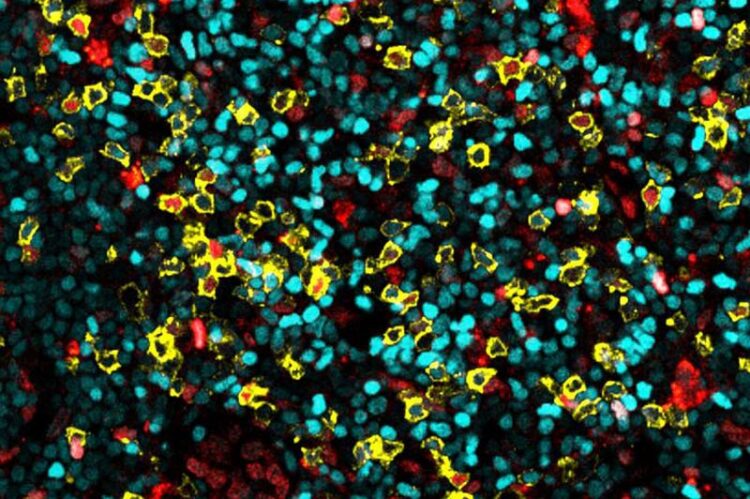Resident T cells discovered in lymph nodes

A picture of immune cells in a lymph node. Resident cells are marked in red, circulating ones in cyan. What is striking is that regulatory T cells (outlined in yellow) are found in both forms.
Credit: Milas Ugur / JMU
The immune system is fast when it comes to fighting viruses, bacteria and other pathogens. But it also has to know when not to attack – for example, harmless substances such as pollen or house dust, which otherwise trigger allergic reactions. Regulatory T cells (Tregs) in the lymph nodes play a key role here, suppressing excessive or misdirected immune responses there.
Researchers at the University of Würzburg (JMU) and the University Hospital RWTH Aachen have now observed a previously unknown behaviour of these cells: “Until now, it was assumed that Tregs circulate between lymph nodes throughout the body to coordinate immune responses,” says Dr. Milas Ugur, head of the study at the Institute for Systems Immunology at JMU. “However, we were able to show that there are also resident Tregs that remain in certain lymph nodes for a long time. Some even nest there for several months!”
Tregs store information about past immune responses
This observation was made possible by a technique called “photoconversion”. It allows cells to be marked by light – with a special torch, as it were – and their changes in position to be observed over longer periods of time. “The result: each lymph node contains a unique set of resident Tregs that map past immune responses,” says Prof. Wolfgang Kastenmüller, Chair of Systems Immunology I at JMU. “There they function as the local memory banks of the immune system.”
Tregs play an important role in allergies and autoimmune diseases. “We now know that these cells can remain locally in lymph nodes for months,” says Prof. Oliver Pabst, study leader and director of the Institute of Molecular Medicine at RWTH Aachen University Hospital. “It is exciting to ask whether this newly discovered property of the cells can also be used therapeutically – for example in allergies.”
But why do some regulatory T cells remain in lymph nodes while others circulate between them? And what does the duration of their stay depend on? The Würzburg and Aachen team wants to get to the bottom of these questions.
The current study was financially supported by the German Research Foundation.
Journal: Science Immunology
DOI: 10.1126/sciimmunol.adj5789
Method of Research: Experimental study
Subject of Research: Cells
Article Title: Resident regulatory T cells reflect the immune history of individual lymph nodes
Article Publication Date: 24-Oct-2023
COI Statement: A.K. is currently an employee at Akkodis Belgium but was not associated with the company during the planning and execution of the study. All other authors declare that they have no competing interests.
Media Contact
All latest news from the category: Life Sciences and Chemistry
Articles and reports from the Life Sciences and chemistry area deal with applied and basic research into modern biology, chemistry and human medicine.
Valuable information can be found on a range of life sciences fields including bacteriology, biochemistry, bionics, bioinformatics, biophysics, biotechnology, genetics, geobotany, human biology, marine biology, microbiology, molecular biology, cellular biology, zoology, bioinorganic chemistry, microchemistry and environmental chemistry.
Newest articles

Properties of new materials for microchips
… can now be measured well. Reseachers of Delft University of Technology demonstrated measuring performance properties of ultrathin silicon membranes. Making ever smaller and more powerful chips requires new ultrathin…

Floating solar’s potential
… to support sustainable development by addressing climate, water, and energy goals holistically. A new study published this week in Nature Energy raises the potential for floating solar photovoltaics (FPV)…

Skyrmions move at record speeds
… a step towards the computing of the future. An international research team led by scientists from the CNRS1 has discovered that the magnetic nanobubbles2 known as skyrmions can be…





















